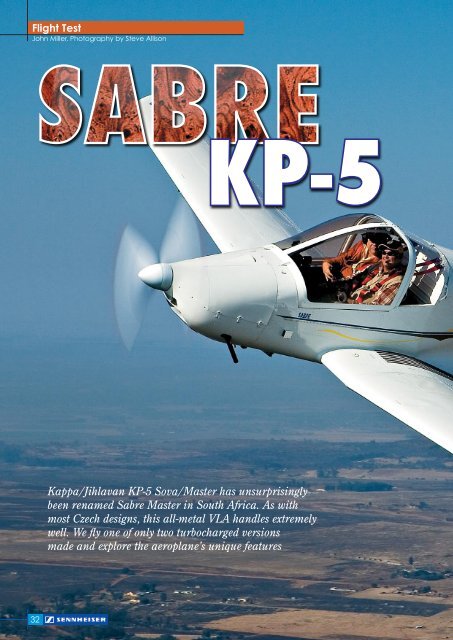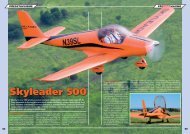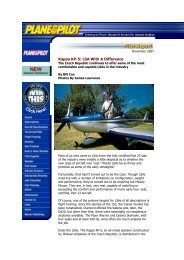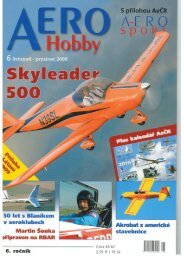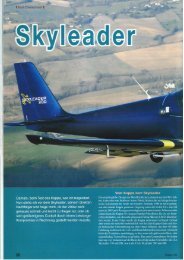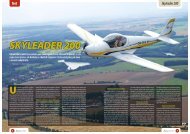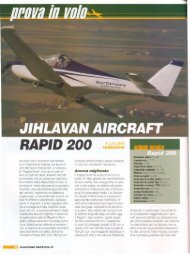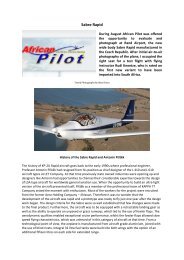Kappa/Jihlavan KP-5 Sova/Master has unsurprisingly been ...
Kappa/Jihlavan KP-5 Sova/Master has unsurprisingly been ...
Kappa/Jihlavan KP-5 Sova/Master has unsurprisingly been ...
Create successful ePaper yourself
Turn your PDF publications into a flip-book with our unique Google optimized e-Paper software.
Flight Test<br />
John Miller, Photography by Steve Allison<br />
32<br />
<strong>KP</strong>-5<br />
<strong>Kappa</strong>/<strong>Jihlavan</strong> <strong>KP</strong>-5 <strong>Sova</strong>/<strong>Master</strong> <strong>has</strong> <strong>unsurprisingly</strong><br />
<strong>been</strong> renamed Sabre <strong>Master</strong> in South Africa. As with<br />
most Czech designs, this all-metal VLA handles extremely<br />
well. We fly one of only two turbocharged versions<br />
made and explore the aeroplane’s unique features
<strong>Master</strong><br />
Vast instrument panel with precision engineered levers and fittings<br />
provides a perfect location for today’s gadget-hungry VLA buyers.<br />
33
Flight Test<br />
John Miller, Photography by Steve Allison<br />
Over the past few years we have come<br />
to believe that ‘metal’ means Cessna or<br />
Piper and ‘Spam cans’ represent everything<br />
heavy, cumbersome and worse – plain old<br />
and boring. In their rightful place though,<br />
hewing aeroplanes out of thin dural and<br />
chrome moly tubing, are the resources upon<br />
which a vast aviation industry, both military<br />
and civilian have <strong>been</strong> built. Composites<br />
were the realm of gliders and only much later<br />
did they become commonplace in general<br />
aviation design. Nevertheless, composite<br />
design <strong>has</strong> never quite managed to shake<br />
the stigma of exotic maintenance needs and<br />
crashworthiness doubts. The never ending<br />
argument between ‘plastic’ and ‘metal’ will<br />
no doubt provide barroom debate for many<br />
future years.<br />
It is once again up to the Czechs to<br />
provide grist in the construction material<br />
debate. Like America, the industrious<br />
Czechs built an aerospace industry on<br />
metal monocoque and tubular steel<br />
34<br />
Staggered seating, stick and rudder pedals work well -<br />
<strong>Jihlavan</strong> <strong>has</strong> since however built a slightly wider fuselage.<br />
designs. They also built numerous gliders<br />
out of metal; indeed, their combination of<br />
engineering design and metalworking skills<br />
<strong>has</strong> produced some of the world’s finest light<br />
aircraft. Blanik sailplanes, once built in huge<br />
precision jigs, are found at almost every<br />
country gliding club, South Africa being no<br />
exception. The Czech Republic <strong>has</strong> always<br />
<strong>been</strong> an enthusiastic member of the world’s<br />
recreational/sport flying community and its<br />
light aeroplane designs are always around<br />
when there are teams to beat and trophies<br />
to be won. The Czechs spawned an aviation<br />
community and manufacturing base out of<br />
proportion to its tiny landlocked size – and<br />
have never stopped innovating.<br />
20 years after Glasnost and the<br />
fragmentation of the Soviet Union and<br />
Eastern Bloc, which left a once proud<br />
aviation industry blinking in the dust<br />
of a vapourised order book, this small<br />
nation is once again at the forefront<br />
of light aircraft design. Previously<br />
institutionalised talent, many of whom<br />
should be enjoying a<br />
Left: Gear retraction<br />
configuration is very<br />
similar to earlier<br />
Zlin 326 and 526<br />
models… and<br />
Russia’s Yak 52<br />
Right: Rubber doughnut<br />
shock absorbers<br />
are a feature of the<br />
delicate looking<br />
main undercarriage.<br />
However, the<br />
mechanism is more<br />
than strong enough<br />
to handle relatively<br />
heavy touchdowns.<br />
Fixed gear version<br />
due in SA soon.<br />
Turbocharged 914 ULS engine <strong>has</strong> <strong>been</strong><br />
installed in only two airframes so far.<br />
serene retirement, have re-emerged to cast<br />
off traditional design values and lead the<br />
world in consumer flying products. One<br />
such is ex LET 410 chief designer, Professor<br />
Antonin Pistek. As he watched his company<br />
suspend production and development of<br />
both the 410 and 610 commuter airliners<br />
followed by disastrous takeover attempts by<br />
US companies, Pistek appeared to gently<br />
retire to the country’s famous aeronautical<br />
university at Brno. Brno is a stone’s throw<br />
from LET’s Kunovice factory and not too far<br />
from Morovan Zlin’s Otrokovice facility close<br />
to the Slovakian border.<br />
The collapse of the Czech Republic’s<br />
aerospace industry in the nineties took with<br />
it promising light aircraft designs intended<br />
to eventually replace the popular Zlin 142
Visibility is superb and almost ag-plane like over the nose. The styling may not be to everyone’s taste but there’s no faulting the Sabre’s fighter-like handling.<br />
and the Zlin-90 series. The Z90 led to a light<br />
version called the TP41, a design developed<br />
to just short of building a prototype.<br />
As the Czechs picked up what was left<br />
of their manufacturing facilities, a company<br />
that emerged was <strong>Kappa</strong> 77, staffed by<br />
ex-workers from aerospace component<br />
manufacturer <strong>Jihlavan</strong>. <strong>Kappa</strong>’s relationship<br />
with <strong>Jihlavan</strong> <strong>has</strong> always <strong>been</strong> strong and<br />
when <strong>Kappa</strong> 77 got into financial trouble in<br />
late 2004, <strong>Jihlavan</strong> stepped in and rescued<br />
the promising TP41 design, or <strong>KP</strong>-2U/5 <strong>Sova</strong><br />
as it had become known.<br />
With an expanding network of<br />
international distributors, the first <strong>KP</strong>-2U<br />
arrived in South Africa in late 2004, imported<br />
by Tedderfield-based Sabre Aircraft run<br />
by Denis Southby and Richard Stubbs.<br />
The design, known locally as the Sabre<br />
<strong>Master</strong>, <strong>has</strong> seen encouraging success<br />
with six aircraft sold, including the unusual<br />
turbocharged Rotax 914ULS engined version<br />
flown for our test report (the company is<br />
awaiting delivery of the first fixed gear<br />
example too). Although <strong>Jihlavan</strong> market<br />
a fixed gear <strong>KP</strong>-5 model, only retractable<br />
versions have so far flown in South Africa. The<br />
turbo’d <strong>Master</strong> is one of two built, the other<br />
owned by Czech propeller manufacturer,<br />
Woodcomp.<br />
The <strong>Jihlavan</strong> <strong>KP</strong>-2U/5 is a celebration of<br />
clever metal structural design and <strong>has</strong> some<br />
unique features. Constructed with thin dural<br />
sheeting held together with blind rivets, the<br />
monocoque airframe is approved to 1,199lbs<br />
(544kgs) and with an empty weight of 282<br />
kgs, fits nicely within our local ultralight weight<br />
limit. Although conventional in structural<br />
design, the aircraft is defined by its large<br />
fowler flaps, retractable undercarriage and<br />
staggered seating arrangement that allow<br />
more shoulder room for larger occupants. The<br />
fuselage is attached to a strong wing centre<br />
section not unlike a DC-3’s. The ailerons and<br />
elevators are controlled by pushrods – an<br />
eastern European tradition that goes a long<br />
way in providing fine handling. The rudder<br />
is connected to the pedals via a cable and<br />
pushrod combination.<br />
Although comfortable and secure,<br />
staggered seating may make the passenger<br />
feel out of touch with the pilot in command.<br />
Sensible in practice, the controls fall within<br />
easy reach of either occupant, the sticks<br />
being staggered as well. Indeed, the cockpit<br />
<strong>has</strong> a light and airy feel and provides great<br />
visibility, both on the ground and in the air.<br />
Flying the <strong>KP</strong>-5 Sabre <strong>Master</strong><br />
Appearance suggests the undercarriage<br />
<strong>has</strong> a flimsy quality encouraging a tentative<br />
step onto the wing to get into the aeroplane.<br />
Nothing could be further from the truth. The<br />
gear is both simple and strong and the huge<br />
forward-hinged canopy opens widely to allow<br />
an easy step into the cockpit. The canopy<br />
might seem to enhance any greenhouse<br />
effect but the engine can be comfortably<br />
started with the perspex in a ‘trail’ position<br />
when a cool blast of air will provide ample<br />
ventilation on hot days.<br />
35
Flight Test<br />
John Miller, Photography by Steve Allison<br />
Huge fowler flaps provide slow stall and touchdown<br />
speeds - a good safety feature.<br />
The seating position provides a<br />
commanding view over the nose, placing the<br />
instrument panel at arms length from the right<br />
hand occupant and enhancing the overall<br />
feeling of space. Indeed, the cockpit gives an<br />
almost MPV, even crop duster elevation both<br />
on the ground and in the air. There is nothing<br />
claustrophobic about flying the <strong>Master</strong>.<br />
As is typical for this level of very light<br />
aircraft, panel design is usually completed<br />
to the whim of the owner and depth of his<br />
or her pocket. Turbo Sabre owner. Brian<br />
Bendall <strong>has</strong> selected a choice woodgrain<br />
finish for his aeroplane. He <strong>has</strong> further<br />
indulged in a pair of Dynon Avionics multi<br />
function primary displays, basic Garmin<br />
VHF and a transponder. He also <strong>has</strong> a<br />
Trutrac autopilot and electric constant speed<br />
Woodcomp propeller and ballistic parachute<br />
for added safety. It is a very well equipped<br />
panel. Analog manifold pressure and water<br />
temperature gauges are positioned at the top.<br />
After start, the Rotax chatters away whilst<br />
the coolant temperature is allowed to rise.<br />
After a couple of minutes, we taxied easily to<br />
Tedderfield’s holding point and completed the<br />
pre-takeoff checks. Steering is positive and<br />
the ride surprisingly compliant considering<br />
the rubber doughnut shock absorbers. With<br />
trim set and one notch of flaps selected<br />
(15-degrees) using the lever mounted<br />
between the seats, the throttle is advanced<br />
all the way to the first stop. A pull-up lever<br />
allows further throttle movement providing<br />
an extra 15-percent power. The Rotax <strong>has</strong><br />
an electronically controlled wastegate, which<br />
is checked during the run-up and enables<br />
the pilot to firewall the throttle without fear of<br />
over-boosting.<br />
The aeroplane was airborne after<br />
a modest ground roll and as the flaps<br />
retracted, trim was easy to adjust using the<br />
push buttons on the top of the stick. I wasn’t<br />
surprised to feel the Sabre’s crisp and light<br />
controls, even at a relatively slow speed<br />
during the climb. The aeroplane’s excellent<br />
handling was confirmed by the ease with<br />
which we formated on SA Flyer’s Cessna<br />
182 for the photographic sortie. I had asked<br />
FPI’s photo pilot, Carl Dollenberg, to maintain<br />
a slowish 110-mph. This provided plenty of<br />
speed margin for our formation turns but was<br />
somewhat slow for the Sabre, which would<br />
have <strong>been</strong> happy at another 20mph or so.<br />
A later chat with Sabre’s Denis Southby<br />
revealed some interesting points about flying<br />
behind a Rotax. He confirmed that these<br />
engines are happy running all day long at<br />
higher power settings rather than the 2000plus<br />
rpms we traditionally fly with Continentals<br />
36<br />
and Lycomings. He asserted that these<br />
diminutive water-cooled powerplants deliver<br />
great performance at 5500rpm with the power<br />
adjusted to lower the manifold pressure.<br />
Although we didn’t try a full power setting<br />
during the evaluation, Denis claims a cruise<br />
speed of over 130 knots with the 914ULS<br />
engine and 120 knots with the normally<br />
aspirated version. Denis says the standard<br />
100hp Rotax is only producing around 75hp<br />
at the highveld’s density altitudes, giving the<br />
914ULS-engined version a significant speed<br />
advantage at higher cruise altitudes. Fuel<br />
burn is between 17 and 20 litres per hour<br />
depending on final choice of power settings.<br />
ZU-EFF is fitted with 94-litre long-range tanks<br />
giving an endurance of around five hours.<br />
Standard fuel capacity is 64 litres.<br />
We stalled the Sabre both with and<br />
without flaps – the aircraft giving a clean<br />
break and sharpish roll off to the<br />
right in either configuration. The<br />
aircraft was quick to recover with<br />
the normal technique of opposite<br />
rudder and a gentle airspeed<br />
build-up.<br />
We returned to Tedderfield<br />
mindful of the 68mph flap<br />
deployment speed and settling<br />
for two notches rather than the<br />
dramatic 35-degrees of full flap.<br />
In this configuration the huge<br />
flaps extend down and rearwards,<br />
contributing to the design’s<br />
remarkable 30mph stall speed. It<br />
is recommended that full flaps are<br />
only used for very short fields and<br />
or where there is a high obstacle<br />
on the approach. The aircraft <strong>has</strong><br />
plenty of elevator authority at slow<br />
speeds and is thus easy to land<br />
and bring to a slow taxiing speed<br />
using the stick-mounted lever<br />
brake.<br />
Like all these very light aircraft originating<br />
from the Czech Republic, the Sabre <strong>Master</strong><br />
is a pleasure to fly and offers the right<br />
combination of simplicity and performance<br />
to satisfy those wanting to explore further<br />
than their home airfield area. As a VLA, the<br />
aircraft offers a real cross-country ability that<br />
equals and exceeds many traditional ‘Wichita’<br />
products, albiet with two seats. However, one<br />
of the most important advantages offered by<br />
this model is the high level of enthusiasm and<br />
knowledge of the distributor, Sabre Aircraft. It<br />
was obvious during a number of discussions<br />
that both Denis Southby and Richard Stubbs<br />
are seriously committed to after-sales<br />
support. Their deals have turned into personal<br />
friendships with a growing and obvious<br />
trust between owners, the factory and the<br />
distributors. With such a sound design, what<br />
more could an owner demand? j<br />
<strong>Jihlavan</strong> SABRE <strong>KP</strong>-5 <strong>Master</strong><br />
Engine<br />
Propeller<br />
Seats<br />
Length<br />
Wing Span<br />
Height<br />
Empty Weight<br />
Max Gross Weight<br />
Fuel Capacity<br />
Range<br />
Cruise Speed<br />
Vne<br />
Agents<br />
Contact<br />
email<br />
website<br />
Price<br />
100hp Turbo Rotax 914 ULS<br />
Woodcomp 3-blade composite<br />
variable pitch<br />
2<br />
7.2 m<br />
9.9 m<br />
2.6 m<br />
282 kgs<br />
475kgs<br />
64 L (optional 94)<br />
960 km<br />
240 kph<br />
260 kph<br />
Sabre Aircraft<br />
Denis: 083 329 9312<br />
richardstubbs@mweb.co.za<br />
www.aircraftafrica.co.za<br />
R580,000 00 + VAT<br />
(Subject to exch rate fluctuations)


